You'll need careful heat management for sun-baked meals because solar cooking relies on precise temperature control for both food safety and quality. Your food must stay above 125°F or below 50°F to prevent dangerous bacteria growth, and reaching proper internal cooking temperatures (145-165°F for meats) requires strategic reflector positioning and regular adjustments every 30 minutes to track the sun. Weather conditions and seasonal changes also impact cooking efficiency, making it essential to monitor and maintain consistent heat levels. With proper heat management techniques, you can master the art of safe and delicious solar cooking.
Solar Heat Distribution Fundamentals
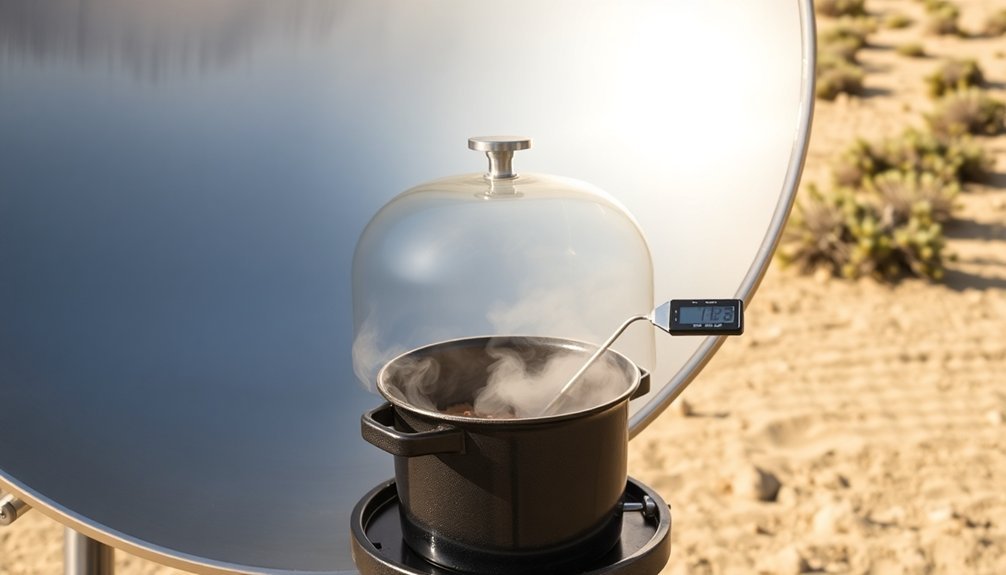
While the sun bombards Earth with endless energy, understanding how solar ovens harness this power requires knowledge of three key heat transfer mechanisms: conduction, convection, and radiation.
You'll see these principles at work as your solar oven converts sunlight into usable heat through electromagnetic waves, which then spread throughout the cooking chamber.
Your dark-colored cooking pot absorbs the sun's radiation and conducts heat through direct contact with the oven walls. Just like a blackbody absorber, it captures nearly all incoming radiation without reflecting energy back to the environment.
Meanwhile, convection currents distribute warm air throughout the chamber, ensuring even cooking.
The temperature gradient between your oven's interior and exterior drives these heat transfer rates.
When you've positioned your solar oven correctly, it'll capture both direct beam radiation and diffuse radiation from the sun, maximizing its heat-generating potential.
Temperature Control Methods
You'll need different temperature approaches when cooking with solar energy compared to conventional microwaves and ovens, which typically operate at much higher temperatures.
These solar ovens can reach temperatures of up to 400 degrees Fahrenheit when properly aligned with direct sunlight.
To guarantee food safety, use a digital probe thermometer to monitor internal temperatures, making sure meats reach their required minimum temperatures of 145-165°F depending on the type.
While reheating times in a solar oven may take 2-3 times longer than conventional methods, you can maintain ideal cooking temperatures by adjusting the oven's position every 30-45 minutes to track the sun's movement.
Microwave Vs Oven Settings
Understanding the fundamental differences between microwave and oven temperature controls can help you choose the right cooking method for your sun-baked meals.
While ovens offer precise temperature control from 150°F to 500°F, microwaves rely on power levels to adjust cooking intensity. You'll find that ovens provide more consistent results for recipes requiring exact temperatures, while microwaves excel at quick reheating and defrosting.
- Ovens let you set specific temperatures, making them ideal for baking and roasting tasks that need precise heat control.
- Microwaves use power levels (200-1200 watts) instead of exact temperatures, better suited for reheating and quick cooking. Advanced models now feature inverter technology for more consistent power output throughout the cooking process.
- Modern microwaves feature sensor cooking technology that detects moisture and adjusts cooking time automatically.
- Convection ovens enhance heat distribution through fan-circulated air, ensuring even cooking throughout your dishes.
Safe Internal Temperatures
Proper temperature control stands at the heart of food safety when preparing sun-baked meals. You'll need to keep cooked food either above 125°F or below 50°F to prevent harmful bacteria growth. If your food stays in the danger zone (125°F-50°F) for 3-4 hours, you must discard it, even if it looks fine.
Raw foods and dried grains can be safely placed in advance when using a solar box cooker before the heating process begins.
To maintain safe temperatures in your solar cooker, you can use dark, thin-walled pots with lids that efficiently convert sunlight to heat.
You'll want to refocus your solar oven every 30 minutes to maintain ideal temperatures, which can reach up to 400°F depending on sunlight conditions. Remember to use the Levelator to keep food level while adjusting the oven's position.
Reheating Time Management
When reheating sun-baked meals, managing time and temperature control becomes critical for both safety and quality.
You'll need to monitor the reheating process carefully to guarantee food reaches safe temperatures while maintaining its taste and texture. Remember that you're working against the temperature danger zone of 41°F to 135°F, where bacteria thrive.
- Reheat your food to 165°F within two hours of removing it from refrigeration.
- Use approved equipment like ovens or microwaves, never slow cookers or steam tables.
- Cover and stir food halfway through microwave reheating to guarantee even heating.
- Allow food to stand covered for two minutes after reheating to equalize temperature.
Following these time management practices helps you maintain food safety while efficiently reheating your sun-baked meals.
Optimal Cooking Surface Placement
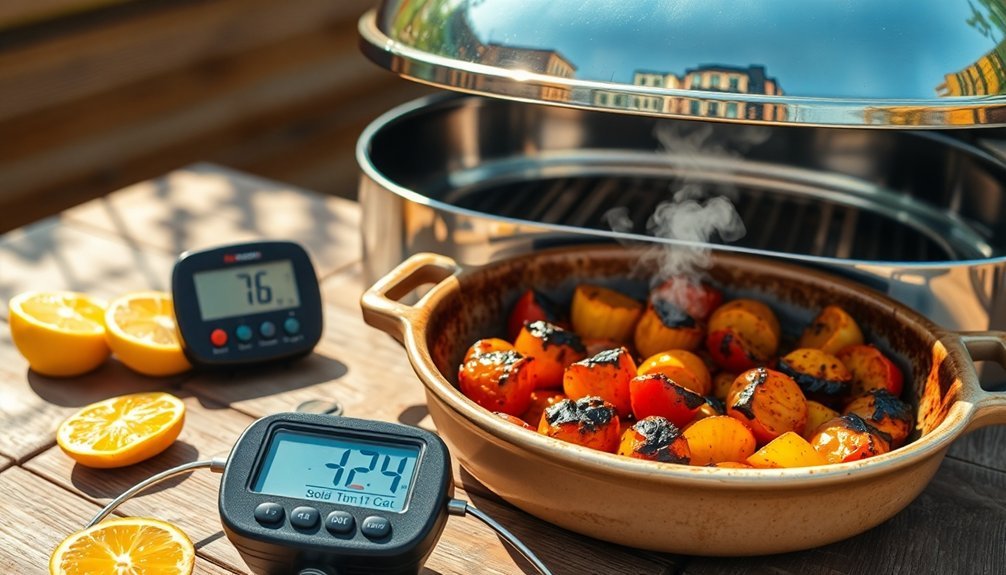
Creating an efficient outdoor kitchen starts with strategic placement of your cooking surfaces 10-15 feet from your home. You'll want to guarantee you're close enough to access utilities while maintaining a safe distance for smoke ventilation.
Position your countertops at 36 inches high, or 38 inches if you're including a fridge.
When planning your layout, allocate at least 12 inches of counter space on each side of your grill and sink. For pizza ovens, provide 24 inches on one side and 12 inches on the other.
Don't forget about traffic flow – leave 5 feet for walkways and 3 feet between islands. If you're adding bar seating, allow 5 feet behind grill islands for comfortable stool placement, plus an additional 3.5 feet for guest circulation.
Reflector Positioning and Adjustments
You'll need to position your solar oven's reflectors at precise angles to maximize sunlight capture, using the EZ-Sun Track indicators to find the sweet spot.
The way you angle your mirrors will directly affect heat distribution, so keep them wrinkle-free and perfectly aligned with the cooking chamber.
As seasons change, you'll want to adjust your reflector setup to account for the sun's varying path across the sky, ensuring consistent cooking temperatures year-round.
Optimal Mirror Angle Setup
The ideal positioning of reflector mirrors plays a critical role in maximizing your solar cooker's efficiency. For horizontal cookers, you'll need to calculate the best tilt angle using the zenith angle formula, while inclined cookers require adjustments based on latitude and declination angles.
- Position your reflectors at no more than 22.5 degrees from perpendicular to the glass for efficient heat reflection.
- Use the E-Z Sun-track indicators to align the sun through both top and bottom holes.
- Adjust your cooker's alignment every 30 minutes to maintain best cooking temperatures.
- Set up the alignment leg to match the sun's position, using wire stakes on windy days.
Remember that taller reflectors work best at 20 degrees off perpendicular, and you'll need to account for your specific location's latitude when making angle calculations.
Heat Distribution Control Methods
Building on proper mirror angles, effective heat distribution depends on strategic reflector management and ongoing adjustments.
You'll need to clean your reflectors regularly since dirt can greatly reduce their heat-capturing ability, which accounts for 40% of your oven's heating energy.
To maintain ideal temperatures between 300° and 375°, you'll need to realign your Sun Oven every 30 minutes.
Start by preheating for 20 minutes on clear days, and use a leveling rack to guarantee even heat flow around your food.
When cooking all day, you won't need frequent adjustments, but shorter cooking sessions require consistent realignment.
For best results, you'll want to monitor the sun's position carefully and use insulated cookware to maintain steady temperatures.
Remember to check that your food reaches safe internal temperatures using a thermometer.
Seasonal Position Adjustments
Successfully operating a Sun Oven throughout the year requires mastering proper reflector positioning and seasonal adjustments.
You'll need to position your oven in an unobstructed area and adjust its alignment using the E-Z Sun-track indicators on the glass door. Make sure the sun's light aligns through both the top and bottom holes for ideal performance.
- Unfold and secure the reflectors using the thumbscrew in the wooden frame.
- Track the sun's movement every 30 minutes for consistent heating.
- Use stakes to stabilize the alignment leg on windy days.
- Adjust the oven's angle based on seasonal sun positions.
Remember to take into account environmental factors like shadows from nearby objects and wind resistance.
You can maintain stable temperatures by securing the oven to a table or the ground, even in snowy conditions.
Weather Impact on Heating
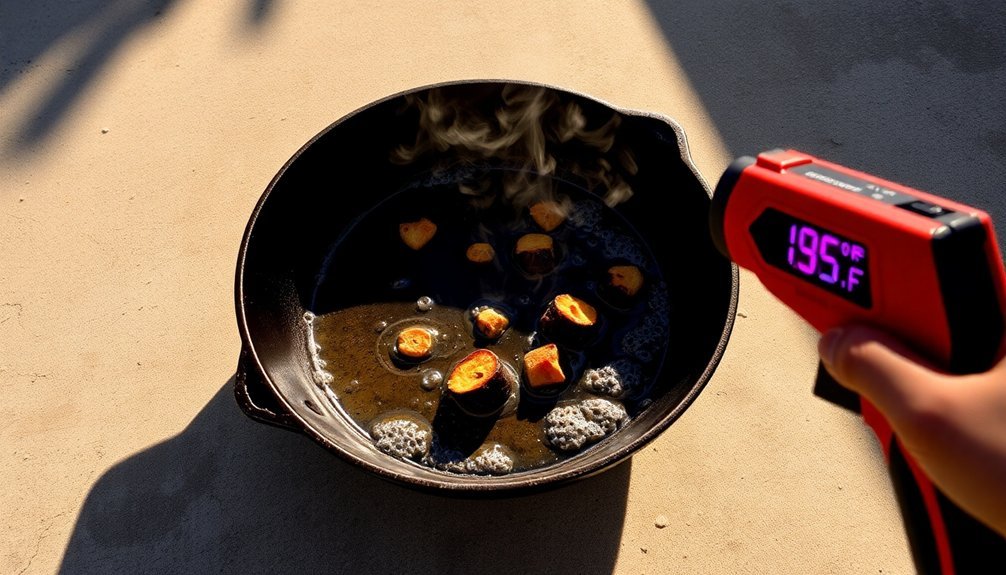
During periods of intense heat, managing food temperatures becomes increasingly challenging as ambient temperatures directly affect cooking and storage conditions.
You'll notice that extreme temperatures can markedly impact your food safety, as bacteria multiply faster in warm environments. When power outages occur, your refrigerated items are at particular risk.
You need to be especially vigilant during heatwaves, as they can compromise your food's safety in multiple ways. Cold holding violations become more common, making it harder to keep potentially hazardous foods at safe temperatures below 41°F.
Weather fluctuations don't just affect stored food – they also influence how your meals cook and heat up. You'll find that high ambient temperatures can alter cooking times and affect how efficiently your cooking equipment performs.
Heat Retention Strategies
You'll get the most out of your sun-baked meals by combining insulated container designs with strategic material choices, such as dark-colored cast iron cookware and aluminum foil lining.
To maintain steady temperatures, you can incorporate thermal mass elements like ceramic dishes or water pans, while ensuring proper insulation with thermal blankets or double-walled construction.
Managing steam through well-fitted lids and moisture control techniques will help you achieve ideal heat retention and even cooking results.
Insulated Container Design Features
When it comes to keeping sun-baked meals hot, insulated container design plays an essential role in maintaining safe food temperatures.
Today's containers feature advanced technology like double-wall vacuum insulation and TherMax systems that greatly reduce heat loss. You'll find that different filling materials in vacuum-insulation panels affect how well your container retains heat.
- Double-walled containers create an air gap between layers that acts as a powerful insulator.
- Vacuum-insulation panels, like those in Thermos® products, keep food warm for up to 5 hours.
- Foam containers use tiny air pockets to minimize heat transfer.
- Self-stacking trays with foam insulation outperform solid plastic options.
The container's holding capacity also impacts its heat retention ability, so you'll want to choose a size that matches your needs while maximizing thermal efficiency.
Temperature Control Materials
To maintain ideal temperature in sun-baked meals, selecting the right combination of heat retention materials makes a critical difference in food safety and quality.
You'll want to start with aluminum foil as your primary reflective barrier, wrapping it around your food to bounce heat back inward. Pair this with thick towels or insulated bags for enhanced thermal protection.
For maximum efficiency, you can incorporate borosilicate glass containers or double-walled glass tubes, which excel at trapping heat through their superior insulation properties.
If you're using a solar oven setup, high-reflectance PET materials will help concentrate solar energy effectively.
Don't forget to preheat your containers with hot water before use, and consider adding passive heat sources like wrapped hot stones or water bottles to maintain consistent temperatures throughout your meal service.
Steam Management Techniques
Proper steam management lies at the heart of efficient heat retention for sun-baked meals.
You'll want to control steam pressure carefully to prevent overheating while ensuring ideal heat transfer. By maintaining dry steam conditions and removing excess condensate, you're maximizing the efficiency of your heating process.
- Control steam pressure to match your specific cooking needs – too high can burn food, while too low won't heat effectively.
- Install separators and drip pockets to keep steam dry and maintain consistent heating.
- Remove trapped air and condensate regularly to improve heat transfer efficiency.
- Recover and reuse condensate to save energy and water while reducing costs.
When you're managing steam properly, you'll achieve better heat retention, consistent cooking results, and improved energy efficiency in your sun-baked meal preparation.
Safety Measures During Cooking
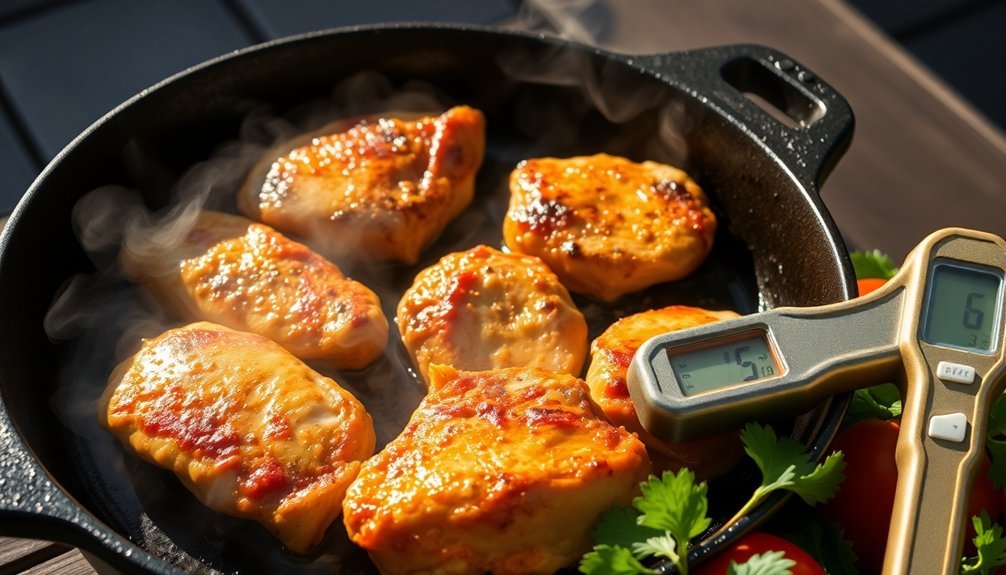
Safe food handling in solar cooking requires strict temperature control to prevent bacterial growth and food poisoning. You'll need to keep cooked food above 125°F (53°C) or below 50°F (10°C). When temperatures fall into the danger zone between these points, harmful bacteria can multiply rapidly.
| Temperature State | Action Required |
|---|---|
| Above 125°F | Monitor to maintain heat |
| Danger Zone | Cool quickly or reheat |
| Below 50°F | Store safely or reheat thoroughly |
Don't leave partially cooked food in a cooling solar box overnight. If clouds interrupt cooking, either finish with alternate fuel or cool the food quickly. You must discard any food that's been in the danger zone for 3-4 hours, even if it looks fine. Never taste suspicious food – bacterial toxins can be present without visible signs of spoilage.
Cooking Time Management
Effective cooking time management makes all the difference when preparing sun-baked meals. You'll need to plan your workflow strategically to guarantee all components of your meal are ready at the best time.
Working backward from your desired mealtime helps coordinate different cooking stages while maintaining food quality and safety.
- Create a weekly meal plan and prep ingredients in advance, including pre-chopping vegetables and marinating meats.
- Arrange your cooking space with easy access to tools and ingredients you'll frequently use.
- Multi-task efficiently by completing prep work while other items are cooking.
- Use time-saving appliances and delegate tasks to family members when possible.
Keep your menu simple and realistic, focusing on dishes that complement each other's cooking times.
Remember to clean as you go to maintain an organized workspace throughout the cooking process.
Food Texture and Doneness

While managing cooking times sets the foundation, understanding food texture and doneness takes your sun-baked meals to the next level. You'll need to monitor temperature closely, as it directly affects how proteins react in your food. Don't rely on visual cues alone – they can be misleading. Instead, use a calibrated food thermometer to guarantee safety and ideal texture.
| Food Type | Safe Internal Temp |
|---|---|
| Poultry | 165°F |
| Ground Meats | 160°F |
| Beef/Pork | 145°F |
| Fish | 145°F |
| Casseroles | 165°F |
Remember that heat causes proteins to denature and coagulate, affecting your food's final texture. When you're cooking with solar heat, maintaining proper temperature prevents tough, dry results from overcooking or mushy textures from undercooking. This applies to both meats and vegetables in your sun-baked dishes.
Equipment Maintenance for Results
Maintaining your solar cooking equipment properly guarantees consistent results and extends its lifespan.
Your solar oven's performance depends on regular upkeep of both its exterior and interior components. You'll need to protect the wooden parts with varnish or hardening oil while keeping the cooking tank clean and well-maintained.
- Apply weather-resistant coating to exterior wood surfaces and check regularly for signs of wear.
- Clean the cooking tank with a soft sponge after each use, avoiding abrasive materials that can damage the surface.
- Inspect and repaint the tank's interior with heat-resistant black paint when needed.
- Store your oven in a dry place using a protective cover to shield it from sun and rain.
These maintenance steps will guarantee your solar oven continues to deliver perfectly cooked meals while maintaining its efficiency.
Seasonal Solar Cooking Adaptations
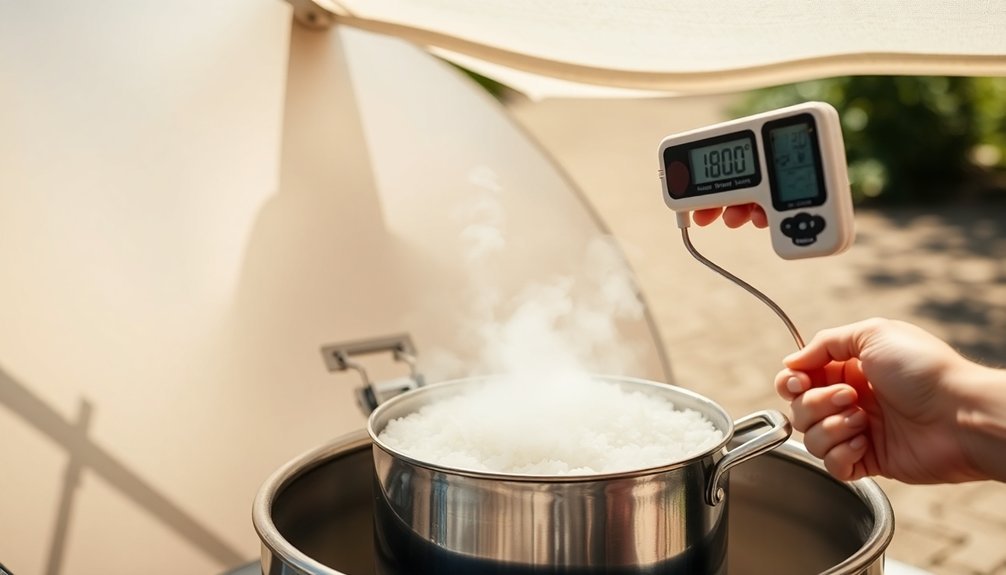
A well-functioning solar oven opens up year-round cooking possibilities, but you'll need to adapt your techniques as seasons change.
During winter months, focus on cooking between 11:00 am and 3:00 pm when the sun's position is most favorable, and you'll want to adjust your cooker more frequently to track the sun's lower path.
You can actually turn winter conditions to your advantage. Cold, dry air often provides more intense sunlight, while snow acts as a natural reflector to boost cooking efficiency.
Keep your cooker indoors until you're ready to cook to minimize preheating time. When cooking, use steam as your indicator rather than opening the lid repeatedly.
Remember to position your reflective panels strategically and use a Sunsight device to maintain ideal sun alignment throughout shorter winter days.
Frequently Asked Questions
Can Sun-Heated Meals Be Safely Reheated Multiple Times?
You can safely reheat sun-heated meals multiple times if you've cooled them quickly, stored them properly below 5°C, and reheated them thoroughly to 75°C. Always monitor temperatures and discard if you're uncertain.
How Do Different Packaging Materials Affect the Meal's Heat Distribution?
You'll find that paper packaging absorbs moisture and prevents sogginess, while plastic traps condensation. Wood trays provide even heating distribution, and microwave-safe containers guarantee consistent temperature throughout your meal during reheating.
What Happens if the Meal's Seal Breaks During Heating?
If your meal's seal breaks during heating, you'll face uneven cooking, potential bacterial contamination, and nutrient loss. You'll also notice compromised presentation and more difficult preparation, making it safer to discard the meal.
Do Certain Ingredients Respond Differently to Sun-Based Heating Methods?
Yes, you'll notice ingredients respond uniquely to solar heating. Dense items like lentils take longer, while watery vegetables cook faster. Spices and aromatics release their flavors more gradually in sun-based cooking.
Can Heat-Sensitive Vitamins Be Preserved During Sun-Based Cooking?
You can preserve heat-sensitive vitamins by using gentle solar cooking methods below 120°C. You'll retain up to 80% of vitamins B and C, especially when you opt for steaming or stewing techniques.
In Summary
You'll need proper heat management for sun-baked meals to achieve consistent, safe cooking results. By monitoring temperatures, adjusting reflectors, and positioning your cooking surface correctly, you're ensuring food cooks thoroughly without burning. Whether you're dealing with seasonal changes or unexpected weather shifts, smart heat control helps you maintain ideal cooking conditions and produce properly cooked dishes with the right texture every time.

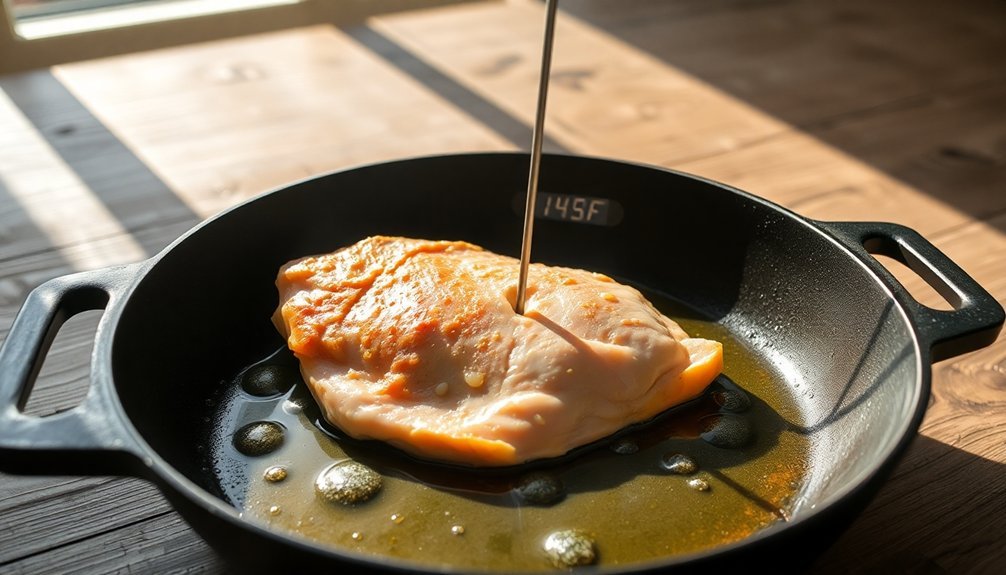



Leave a Reply